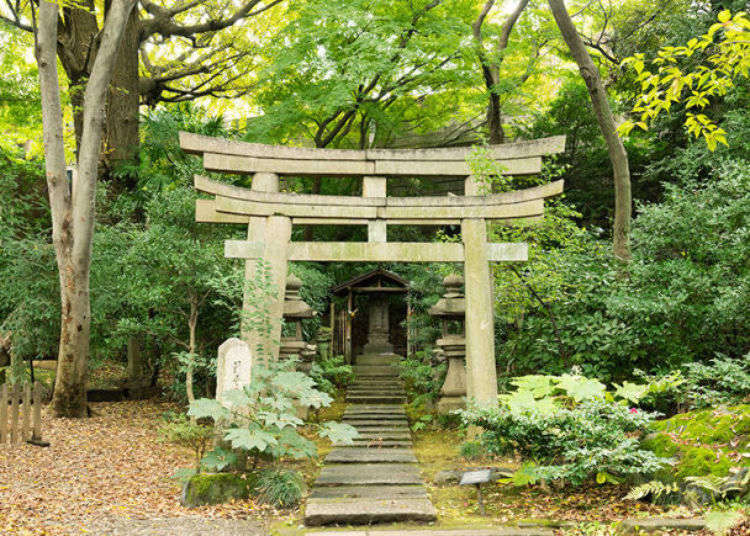
Nezu Art Museum is located near Omotesando Station in Minato Ward, Tokyo. Here you can enjoy eastern antique artworks which were collected by Kaichirou Nezu (1860-1940), a railroad baron and philanthropist. This is one of the few art museums in Japan which opened before World War II.
Here we will introduce the appeal of Nezu Art Museum, not only its exhibitions but also its popular original goods and café where you can enjoy a fantastic view of this authentic Japanese garden in the center of the city.
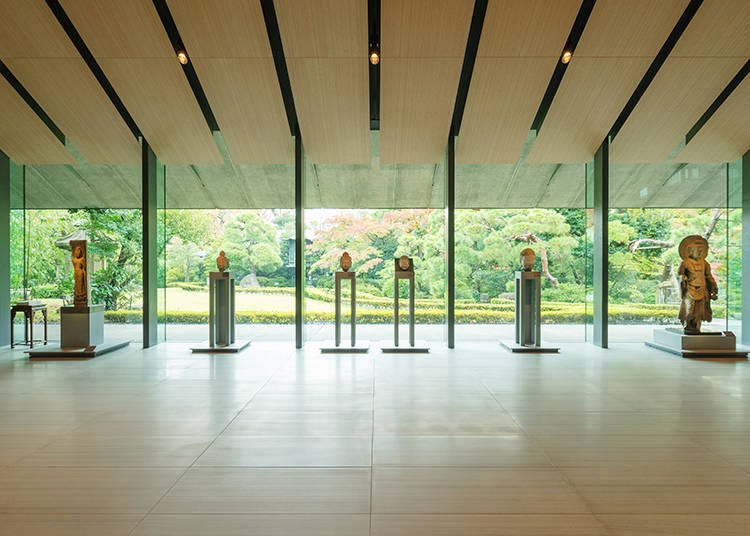
The bamboo building makes people nostalgic and think about its history
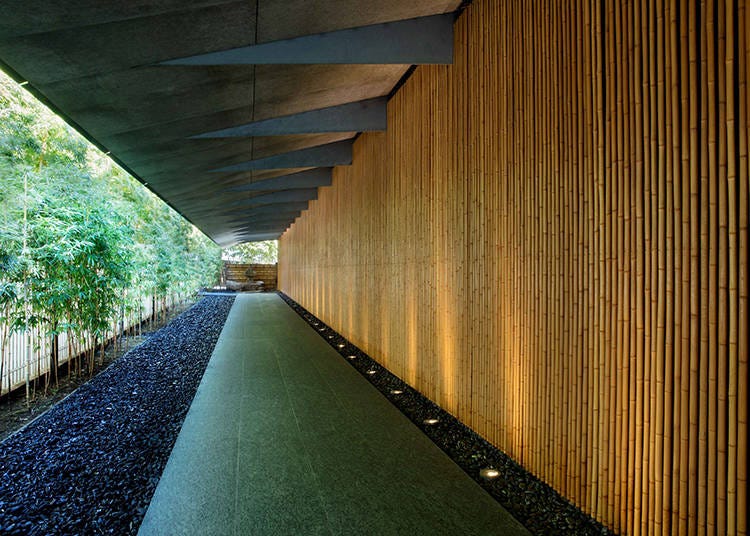
Walk along Miyuki Street for 8 minutes after you go out of the A5 exit of Omotesando Station on the Chiyoda Line, Hanzomon Line, and Ginza Line.
You can see luxurious bamboo hedges across the junction. You might be surprised to see bamboo hedges in the center of the city. Cross the street to go into art museum’s main gate.
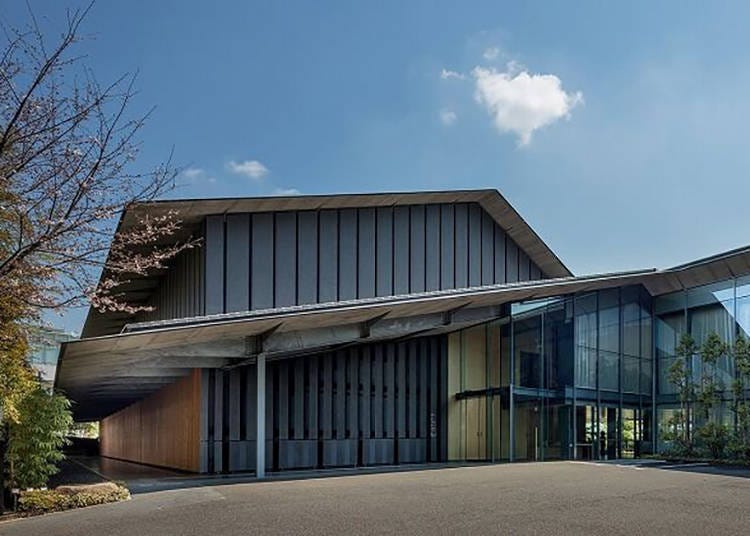
This is a large building which has 2 stories above ground and 2 below with an open feeling, because of the use of glass in the building.
The exhibition hall had its renewal opening in 2009. The renovations were done to give the appearance of Nezu’s home when the museum was first opened. The original structure was burned by airstrike. The art survived and was put on display temporarily at a barracks that survived the fires in 1946. Reconstruction of the building began in 1954 with the new exhibition hall created in 1991.
The renovations for the renewal began in 2006, with the exhibition hall completed 2009. Kengo Kuma a big name among Japanese architects designed it and it is highly revered at home and abroad as an exquisite architectural work of harmony with both a modern and old Japanese atmosphere.
A large collection of eastern fine art

Pay the admission fee at the reception desk near the entrance to enter the hall. Rays of light shine through the big glass windows that makes the room both bright and broad. Ten statues of Buddha are displayed along the windows and walls.
This entrance is the only path to enter the exhibition in the museum. Unlike other exhibition rooms, pictures are allowed, so many people take commemorative photos here.
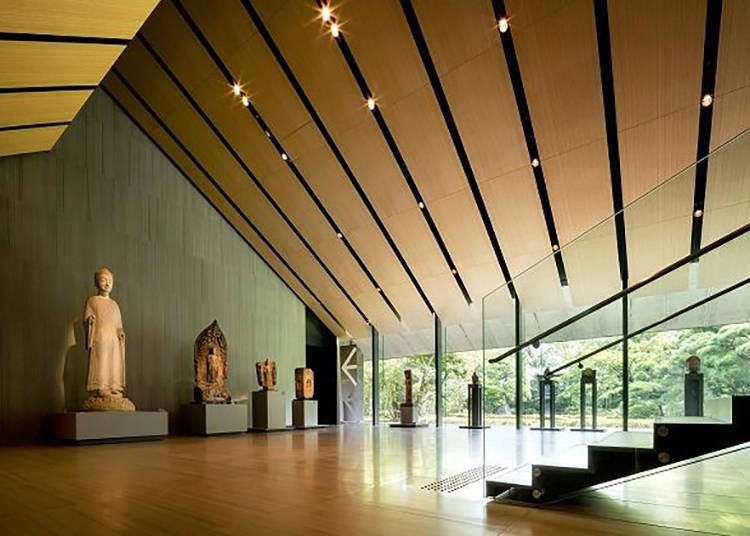
Many exhibitions were made in China between the sixth to eighth centuries. One of the most popular works is the Miroku-bosatsu-ritsuzou statue which was made in the Gandhara region: currently an area of Afghanistan and Pakistan. It is influenced by Greek and Roman cultures with a noble face, that could even be considered as handsome today.

The attraction of Buddhist art will be exhibited in the entrance and exhibition room 3 for a long period of time. The Jizou-bosatsu-ritsuzou statue is currently displayed in exhibition room 3. One of these statues is important cultural property of Japan made in 1147: the third year of the Kyuan era in Heian period.
Pictures are not allowed there, but this time we were granted special permission to take pictures.
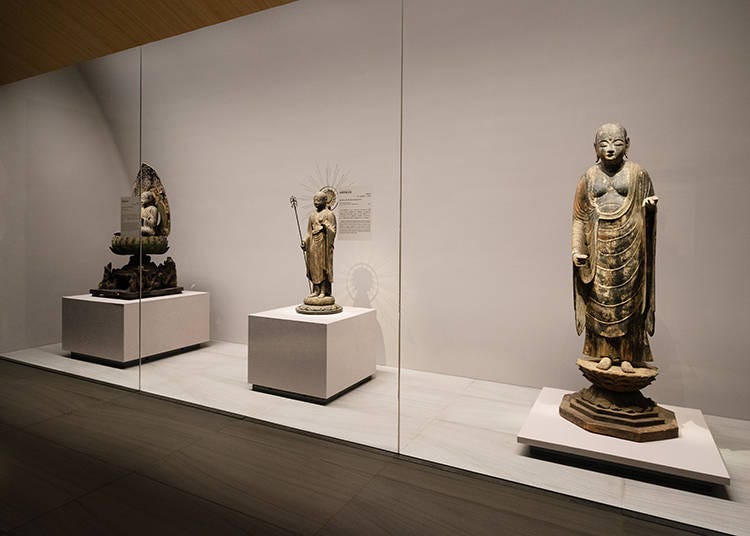
It has a solemn atmosphere in the room, with a gentle smiling face of Miroku-bosatsu that is calming. Delicate details such as creases on the clothes and plump cheeks, allows viewers to gather an impression of the sculptor’s feeling.
In the main exhibition room on the first floor, special exhibitions are held two or three times a year, planned exhibitions are four or five times. Themed exhibitions are also held on the second floor of the exhibition hall. Tickets allow for full access to see all exhibitions in the museum.
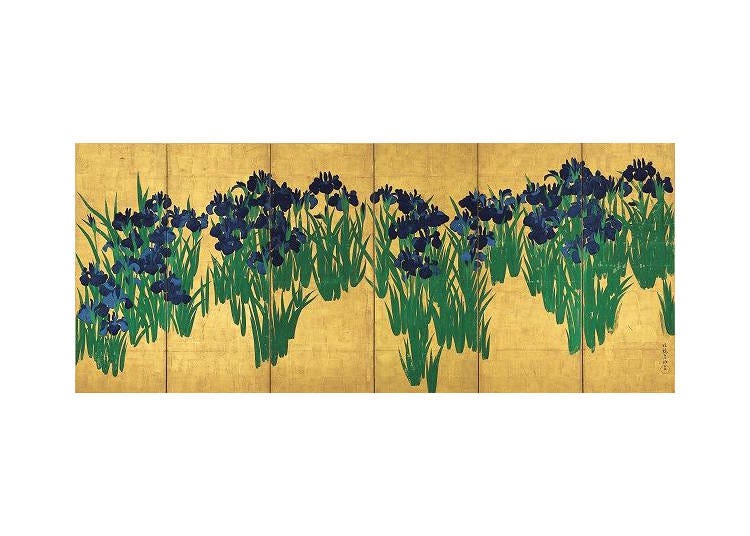
There are over 7,400 items on display such as pictures, tea-related items, lacquer works, and metal works. There are 7 national treasures, 87 important cultural properties, and 94 art treasures including Kakitsubata-zu-byobu made by Kohrin Ogata in December 2018. This is one of the greatest antique art museums in Japan in both quantity and quality.
To protect the delicate and antique art, it is important to hold various themed exhibitions and change exhibits regularly. This way many people can also get a chance to see many art works.
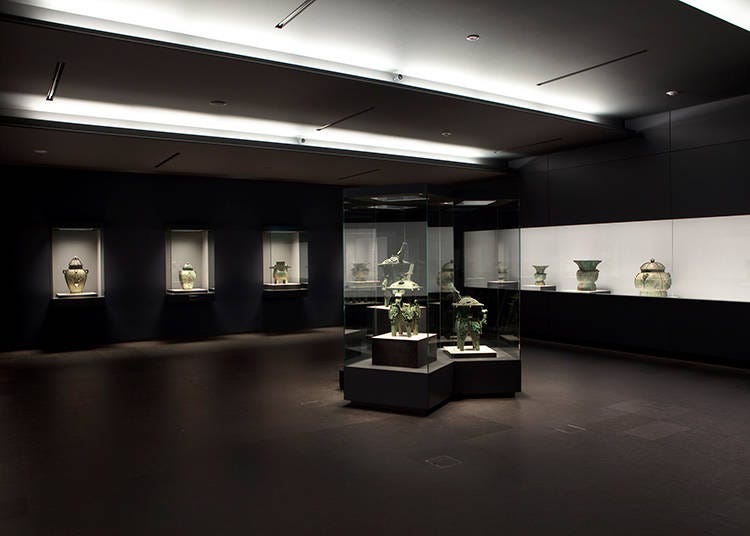
In the special exhibition, you can see famous works that belong to other museums. In the themed exhibition, you can enjoy many great works selected from the numerous art items for their selected theme. A wide range of exhibitions are held with such genres as tea cups and wares, Buddhist art, pictures, Chinaware, etc. Please check the exhibition schedule on the website.
Usually, museums are made from personal collections and tend to be inclined to a particular field. Here, however, you can find abundant and various collections of Kaichirou Nezu said to be “Nezu-no-waniguchi” which means the “wide mouth of Nezu,” and is used in a figurative sense for the wide range of genres in his collection.
Forget about daily life in this authentic Japanese garden and enjoy walking in tranquility
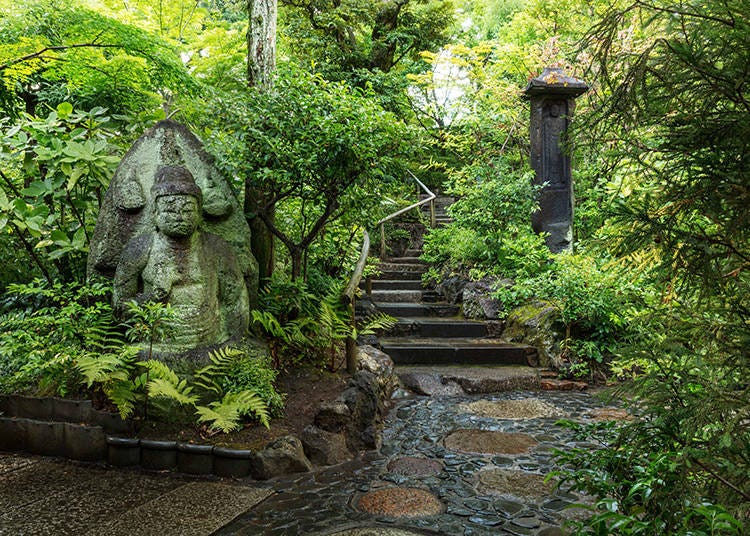
Another attractive part of the Nezu Museum is the authentic Japanese garden which is hard to believe is in the center of the city. Once you step inside, you can get a seasonal scenery of rich nature in front of you. Fresh air as if in the forest makes you forget that you are in Tokyo.
The garden goes lower as you head toward the pond in the center. This bowl like style makes it feel it has a greater depth than it actually has. The path in the garden winds like a snake, which allows visitors to enjoy the view of the garden in different directions and also creates a more spacious feel.
The gardener is the third generation of the family that originally took care of the garden for Nezu Museum since before World War II. In addition, the gardener's skills and hospitality can be seen throughout the museum.
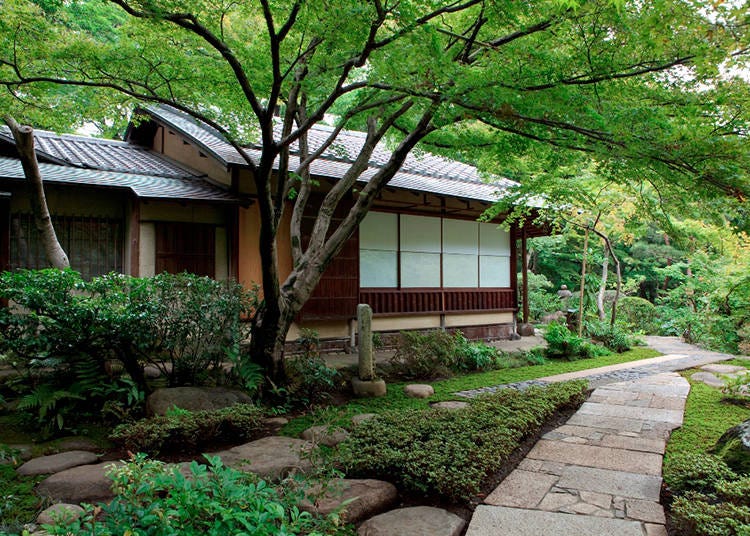
There are great must-see places in the Nezu Museum called the “Top 8 views of Nezu Museum (hakkei).” You can take pictures in the garden, so be sure to go there to take photogenic pictures!
One of the top eight views is “Fukiage-no-izutsu”which means low stone fence covering a well. There is an entrance named “Teien-guhi,”and when you go to the garden and go down the path. You will see a square stone fence in the center of the big pond.
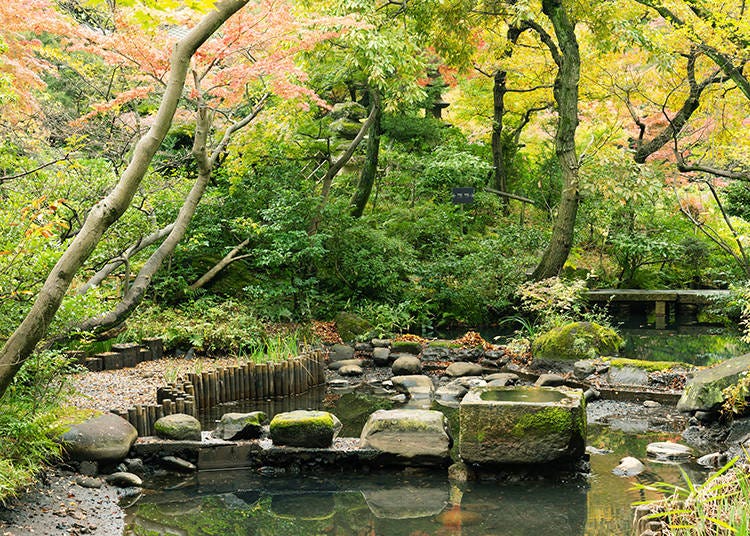
Water from the pond emerges from this well and is the origin of its name “Fukiage.” The surrounding area is full of trees that has fantastic scenery as if visiting an old town in the mountains.
As you go around the pond to the left, you'll see a torii gate. This is Tenjin no Hibaishi, considered the second-best view around the garden. The name 'Hibaishi' is written with the Kanji characters for 'flying' and 'plum blossom', and derives from the legend of a plum tree which came flying in the air and took root here.
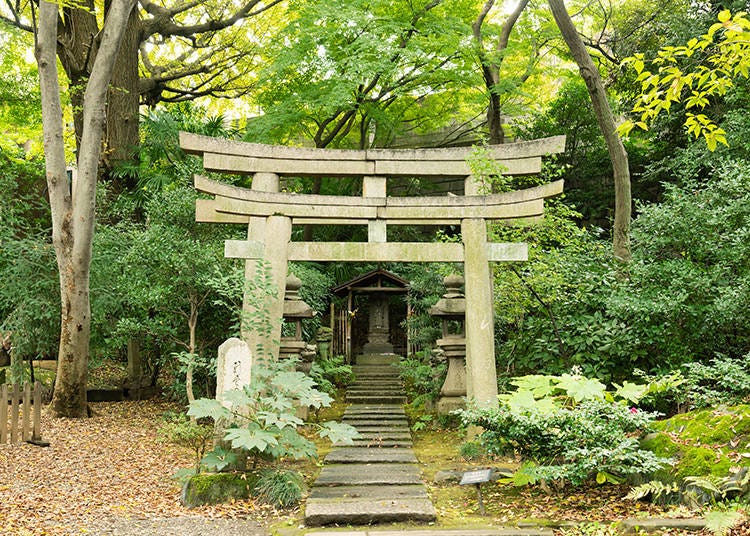
This small shrine has a quaint atmosphere where many students preparing for an exam often visit as it embodies Michizane Sugawara who is famous as the Shinto deity of scholarship. Many pencils and pens were offered under the stone statue at the time of our visit.
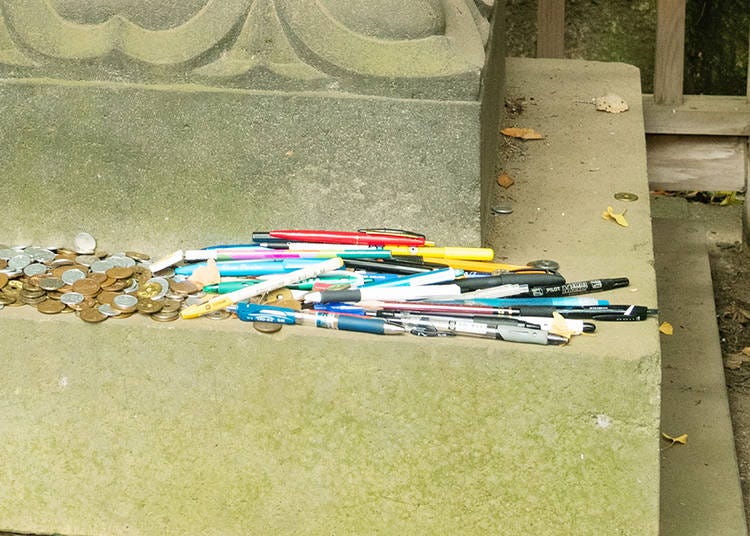
Following the road, there is a historic building. It’s a Buddhist temple called “Yakushi-dou,” where the Buddha of healing is enclosed. Moso bamboo grows around the temple. It’s called “Bamboo of Yakusi-dou” and is one of the top 8 views.
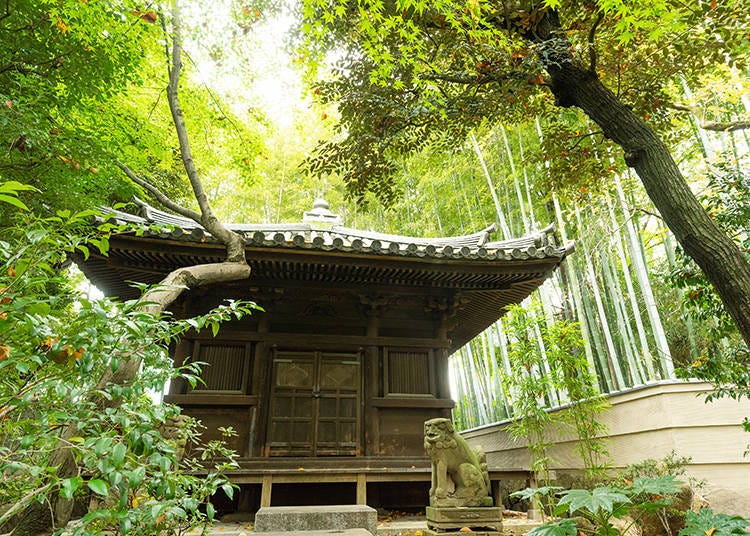
It is a quiet space where you can hear the bamboo leaves rustling in front of the “Yakushido” that has a mysterious old city feeling as if you were back in the Heian period.
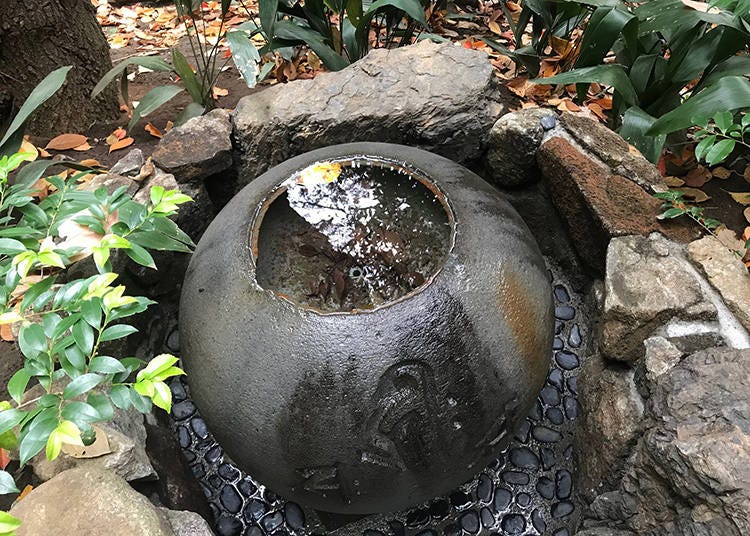
Turn back and go along the broad walking path to see the stone statues standing from a distance. The fourth of top 8 views is Mt. Potalaka, which has many stone Buddha statues and stone pagodas. “Kannon-bodhisattva,” which is over 3m, is the most famous of them all.
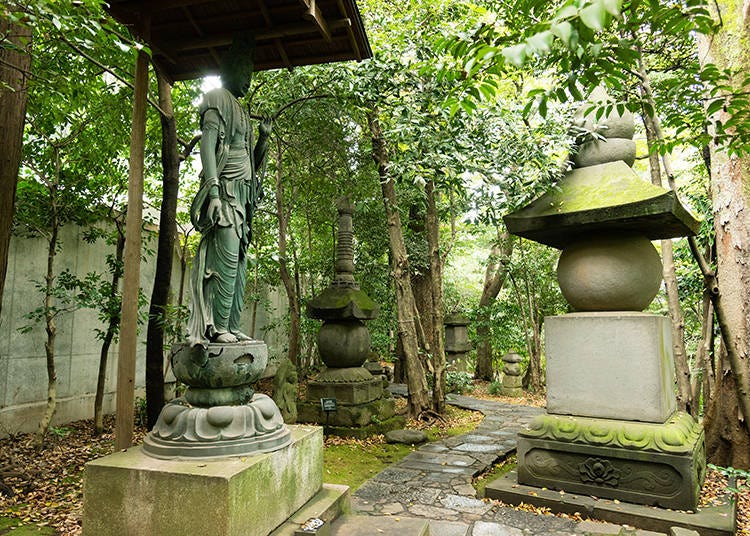
Mt. Potalaka sounds like a cute name in Japanese, but the name actually comes from the legendary place where “Kannon-bodhisattva” lives. There are many stone Buddha statues big and small, that gives this spot a unique and exotic atmosphere.
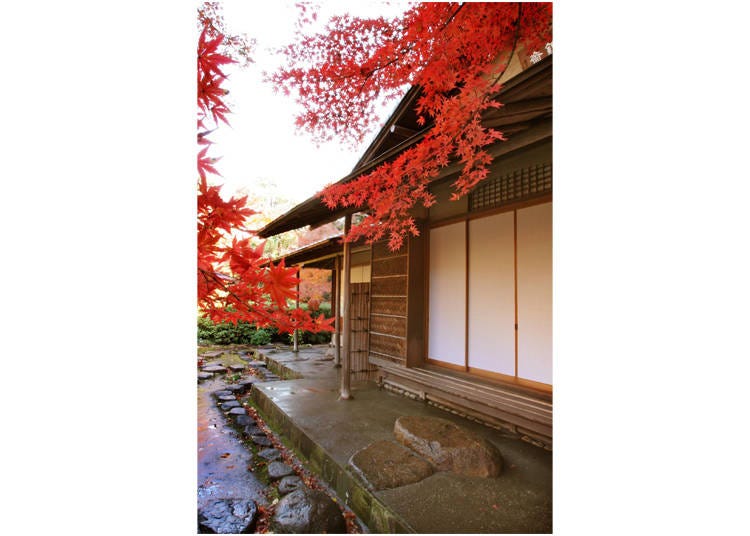
Another one of the top 8 views is “Maple Trees by Hisaibashi” where green leaves in early summer and autumn leaves are beautiful, and “Irises at the Konin-Tei” where irises bloom during Golden Week. “Kakitsubata-zu-byobu”, a national treasure, is exhibited when the irises bloom.
We recommend going to see both of these beauties. “Kakitsubata-zu-byobu” will be displayed in the special exhibition “Kakitsubata-zu by Korin Ogata, celebrating paintings of the Edo period” which is held from Saturday, April 13th to Sunday, May 12th.
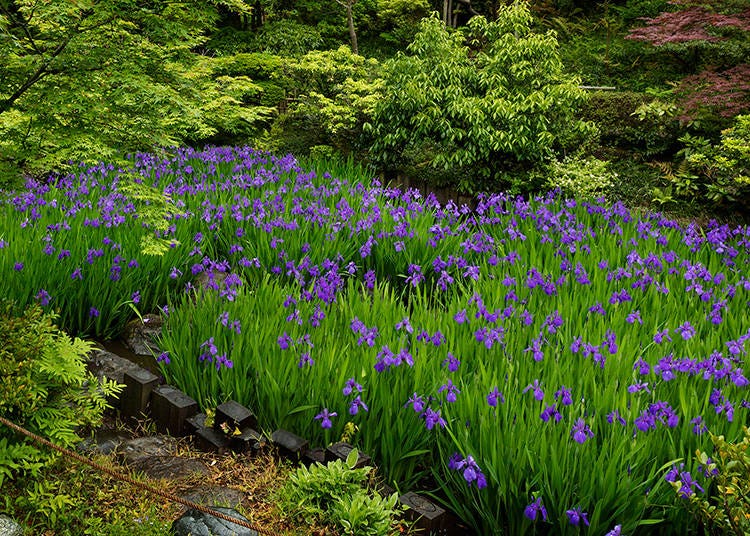
Please ask clerks in the museum for the best viewing times.
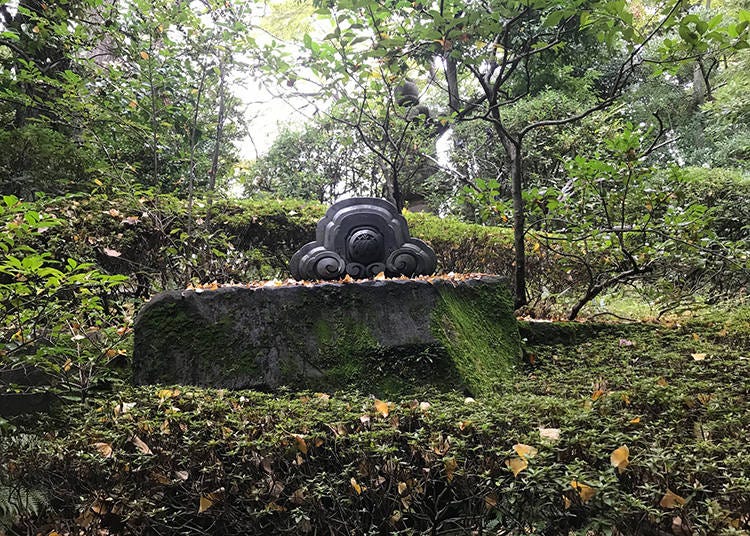
There is one of the top 8 views around the main entrance. It is the “Moon-shaped stone boat,” which is a stone lantern and a tsukubai, a stone wash basin, which was used in Nezu’s house.
Seeing the light of the crescent-shaped stone lantern in the moonlight is quite romantic as well.
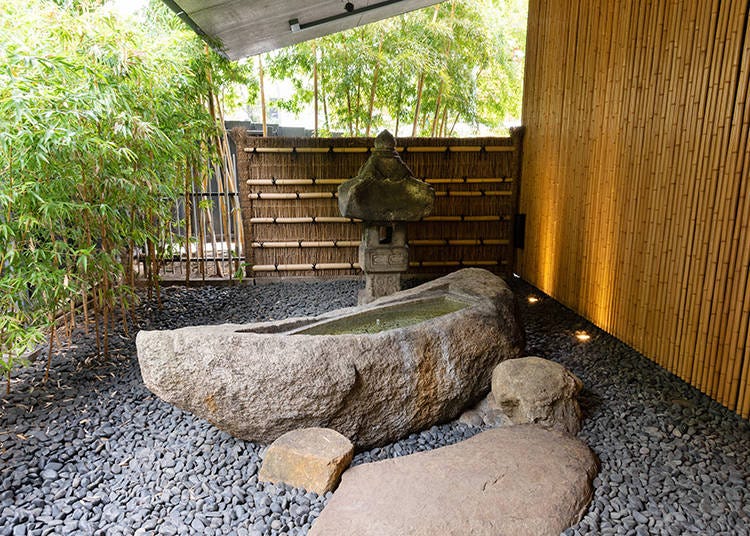
After walking in the garden, have a break in NEZUCAFÉ!
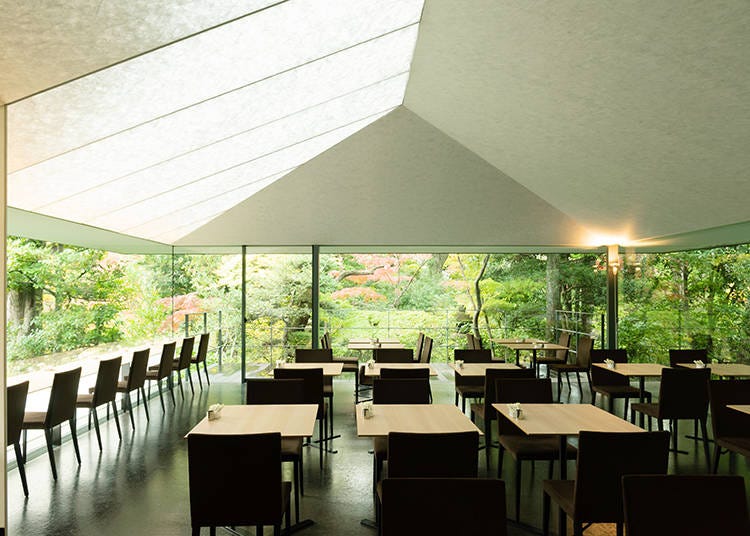
NEZUCAFÉ is a comfortable and bright café with sunlight shining through the large windows. A counter faces the garden and is especially popular for people to come and drink coffee alone while they relax.
Shortcake, the standard café menu is the most popular. It looks luxurious with its rich white cream and two beautiful strawberries. This mild cream is not too sweet and goes well with the light and fine sponge. Sour-sweet strawberries bring out the flavor and texture.
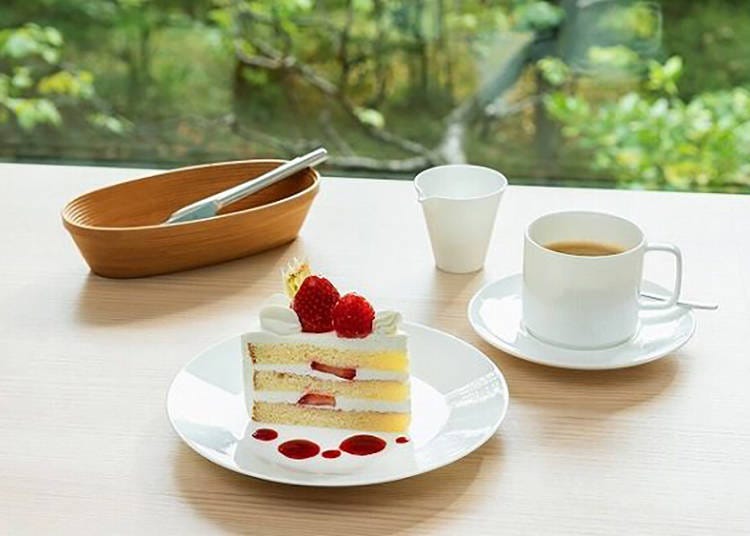
Nicoise-style salad with bread (1,000 yen) and meat pie & salad (800 yen) are also popular dishes.
Try their lunch option that uses seasonal ingredients with “Today’s pasta, (1,000 yen)” or “Today’s Hamburg steak with bread, (1,350 yen)” You can spend your time in luxury watching rich nature that makes it hard to believe you are in the city center.

The museum shop is filled with charm!
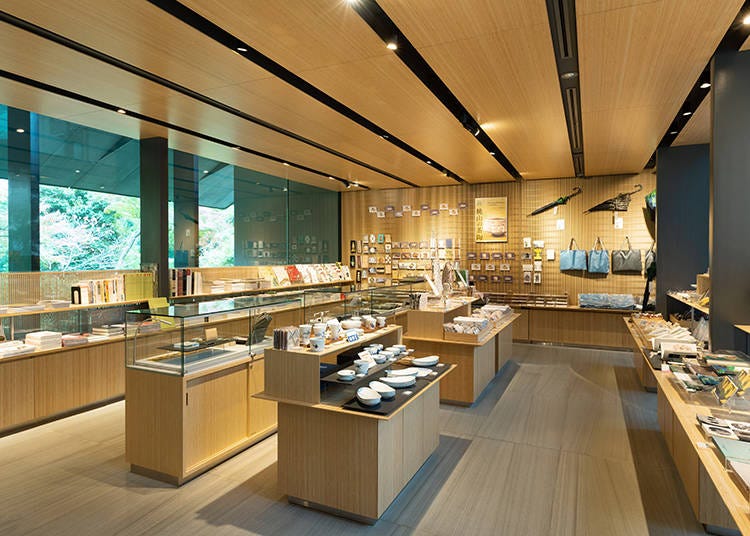
After enjoying the highlights of museum, go to the Museum shop. It is jammed packed with original goods such as exhibition catalogs and postcards for standard products, umbrellas designed using garden and museum item motifs, bags, tableware, and Japanese paper tape.
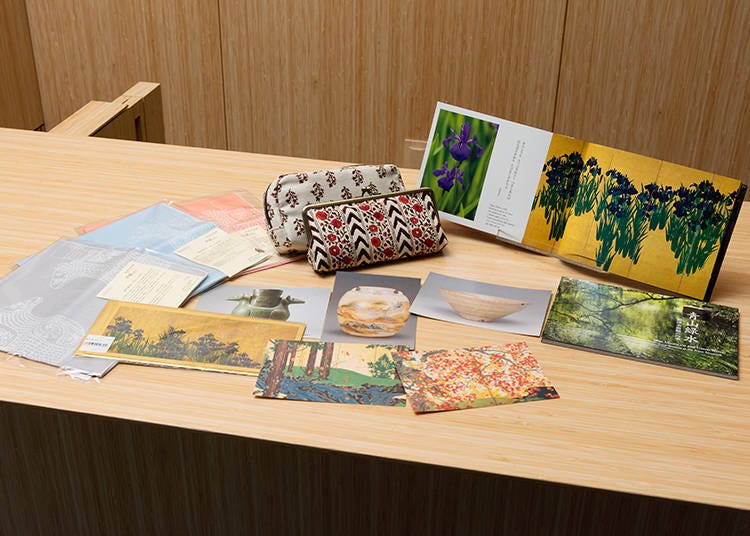
“All the seasons of Nezu Museum,” is a popular photo book which includes pictures of the museums items and all the seasons of the garden, published in 2018.
Photographer Yuji Hori took pictures only to be used in this photo book, with Japanese poetry written in each picture for all the seasons. This gift would make a great present not only for yourself but for your family and friends.
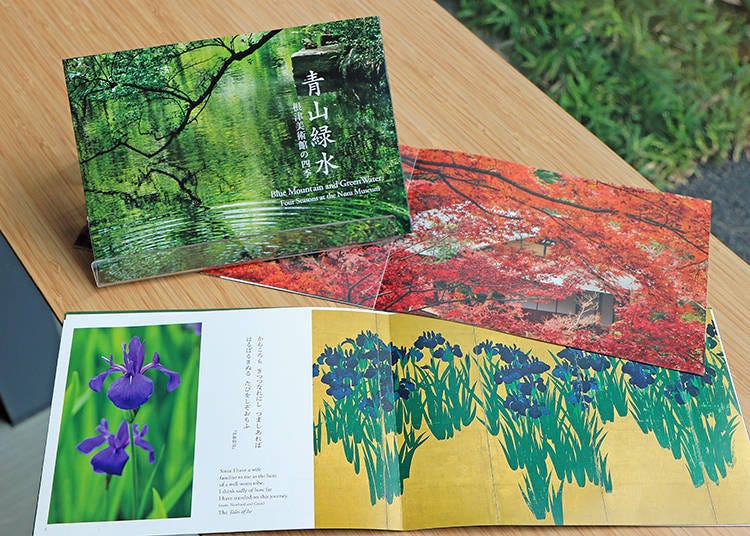
We went out the front gate of Nezu Museum with a feeling of well-being, there was the view of the city as usual. Being confused I looked back, with green bamboo rustling in the wind it made me feel as if time passed so differently in this place. We will come back here again when searching to be healed through silence, oriental art, and a green Japanese garden.
The Nezu Art Museum is the best place for who those who are busy everyday and want to enjoy a special time in their trip. We invite you to visit if you live in a noisy and boisterous large city and want to forget daily life.
Photographed by Daisuke Yanagi
-

-
Address
6-5-1, Minamiaoyama, Minato-ku, Tokyo, 107-0062
View Map -
Nearest Station
Omotesando Station (Tokyo Metro Ginza Line / Tokyo Metro Chiyoda Line / Tokyo Metro Hanzomon Line)
10 minutes on foot
- Phone Number 03-3400-2536
-
Address
6-5-1, Minamiaoyama, Minato-ku, Tokyo, 107-0062
- Area
- Category
*Prices and options mentioned are subject to change.
*Unless stated otherwise, all prices include tax.
Popular Tours & Activitiess
Recommended places for you
-

First Japan Cherry Blossom 2026 Forecast Announced! Here's When & Where to See Sakura in Japan
-

Jujutsu Kaisen Takes Over JR East With a Wrapped Shinkansen This Winter
by: Guest Contributor
-

Strawberries, Style, and Tokyo’s Coolest Neighborhood: Winter Afternoon Tea in Kichijoji
by: Guest Contributor
-

New in Ginza! Air BicCamera Ginza Opens with a Faster, More Convenient Shopping Experience
by: Guest Contributor
-

How to Get Don Quijote's Exclusive 2025-2026 Winter Gift (+Tax-Free Savings)
-
Ad

Discover the "Miraculous Forest" in the Heart of Tokyo: The Institute for Nature Study (9 Minutes from JR Meguro Station)
Inspiration for Accommodations
-

Enjoy Mt. Fuji from the Comfort of Your Room! Recommended Ryokan with Mt. Fuji View
-

Stay Near the Cherry Blossoms! Hotels for Cherry Blossom Viewing in Tokyo
-

Family-Friendly Hotels with Free Shuttle to Disneyland: Convenient Access for a Magical Stay
-

Top Ranked Hakone Hotels with Mt. Fuji View: Enjoy Stunning Scenery from Your Private Space
-

Convenient Tokyo Hotels with Airport Shuttle: Ideal for Families and Heavy Luggage
-

Stunning Tokyo Tower View Hotels: Enjoy Spectacular Scenery from Your Private Space
-

Convenient Asakusa Hotels with Kitchens: Ideal for Extended Family Visits
-

Experience Luxury: Hakone's 10 Best Five-Star Accommodations
-

Enjoy Mt. Fuji Autumn Leaves! Top Hotels Near the Popular Autumn Leaves Corridor
-

Experience Hakone Fall Foliage from Your Room with Stunning Views
-

Autumn in Japan 2025: Fall Foliage Forecast & Where to Enjoy the Colorful Leaves (+Tour Info)
-

Tokyo Roppongi|Roppongi Station Area Map & Sightseeing Information
-

The Best of Japan: 11 Major Cities Every Traveler Should Visit
-

Tokyo Roppongi: 5 Most Amazing Spots at Roppongi Hills and How to Make the Best of Them!
-

Five gardens to get to know the wabi-sabi of Japan
-

(Video) Walking Tour along Narita Omotesando - Quaint Historical Village near Narita Airport!
by: Victor Gonzalez
- #best ramen tokyo
- #what to buy in ameyoko
- #what to bring to japan
- #new years in tokyo
- #best izakaya shinjuku
- #things to do tokyo
- #japanese nail trends
- #what to do in odaiba
- #onsen tattoo friendly tokyo
- #daiso
- #best sushi ginza
- #japanese convenience store snacks
- #best yakiniku shibuya
- #japanese fashion culture
- #best japanese soft drinks



















